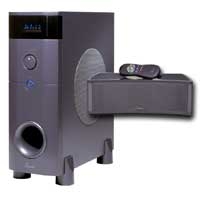One for All!

Everyone appreciates surround sound as a part of a home theater, but many people don't enjoy being surrounded by speakers. At the 2005 International CES, Yamaha, Definitive Technology, and others introduced alternatives to a room full of speakers. Yamaha's YSP-1 Digital Sound Projector reproduces all the main channels for a 5.1-channel system, including amplification, with 42 small drivers in a single panel placed below the screen. Available in February at a list price of $1,499.
Yamaha's YSP-1 Digital Sound Projector (available in February, $1,499) replaces five conventional speakers with a single plasma-friendly panel roughly 50 inches wide, 8 inches high, and 5 inches deep that mounts below the screen. The stylish silver grille conceals 40 individual 1 5/8-inch drivers, each fed by its own 2-watt amplifier, plus two 4 3/8-inch drivers with individual 20-watt amps (total power is 120 watts). Individual digital signal processing (DPS) engines for each driver control the timing and level of their output to fool the ears into perceiving the sound as if it came from multiple speakers arranged around the room as in a conventional 5.1-channel system. There are three digital audio inputs (one coaxial and two optical) as well as two sets of analog inputs, and the speaker is fully compatible with Dolby Digital, Dolby Pro Logic II, DTS, and DTS Neo:6 input signals.
Several YSP-1 systems were set up throughout Yamaha's exhibit area, demonstrating performance in different placements. One setup had the TV in the corner of the room - a typical situation that can make proper speaker placement difficult. But the YSP-1 placed underneath the TV delivered loads of surround sound, with some sounds truly seeming to came from behind the listener. And don't let the low power rating fool you - this speaker rocked, easily playing DVDs at cinematic levels.
Another option is to use a single speaker for just the three front channels. At last fall's custom installers Expo, Boston Acoustics introduced its P400 ($1,500), which combines completely separate inputs and drivers for the left, center, and right front channels in one attractive on-wall speaker. At CES, Definitive Technology followed suit with the new Mythos Solo (available in May, $699), which has two 3 1/2-inch midrange drivers and a 1-inch pure-aluminum dome tweeter for each channel, along with two additional 3 1/2-inch passive radiators to boost the bass. The panel fits above or below the screen and is 40 inches wide and is only about 4 inches high and deep. Unlike the Yamaha YSP-1, the Mythos Solo doesn't include amplification, and it's expected that most people will use it together with conventional surround speakers. But if you buy a pair, you can use the second one for left, right, and center surround channels. Like all Mythos speakers, the Solo is available in polished silver or black.
For those who don't mind having five or more separate speakers, plus a subwoofer, as long as the main-channel satellite speakers are small, Definitive Technology also showed its smallest Mythos speaker yet, the new Mythos Gem ($250 each), teamed with its smallest subwoofer, the SuperCube III with a 650-watt amplifier ($700). A complete 5.1-channel home theater package with four Mythos Gem left/right satellites, a matching center speaker, and a SuperCube III sub costs $2,000. Matching stands are $260 a pair.
 |
| Binaura's Sound Environment system ($399, available mid-February) consists of a three-driver main speaker and a subwoofer connected by a single cable. The subwoofer contains the amplification. |
Binaura considers its new Sound Environment system (available mid-February, $399) an audio accessory to video. The processing and amplification are housed in the subwoofer (20 watts x 3 for the main speaker, 60 watts for the sub), which connects to the wing-shaped main speaker with a single cable. Three digital inputs (two coaxial and one optical) are provided along with two sets of analog inputs, making it a breeze to connect a DVD player, a TV, and a gaming system. Patented processing takes Dolby Digital or DTS audio signals, whether multichannel or stereo, decodes them, amplifies them, and passes them to the main speaker.
While the Binaura system didn't produce the same degree of envelopment as the Yamaha YST-1, it did deliver much better sound than you typically get from a TV's own stereo speakers. If you've been intimidated by all the components needed for a standard 5.1-channel system, or are considering a second system for a small bedroom or a kid's gaming room, the Sound Environment is definitely worth a listen. Few other products can enhance the viewing experience so cheaply or easily.
- Log in or register to post comments



































































